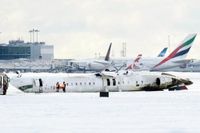TORONTO (AP) — A Delta Air Lines jet crash-landed in Toronto on February 17, 2025, resulting in a dramatic incident that sent 21 people to the hospital. Fortunately, all 76 passengers and four crew members survived the harrowing episode.
According to a preliminary report released by the Transportation Safety Board of Canada (TSB) on March 20, 2025, the incident was marked by a high rate of descent as the aircraft made its approach. The report indicated that the plane’s ground proximity warning system sounded just 2.6 seconds before touchdown, at an airspeed of 136 knots, or about 250 kilometers per hour (155 miles per hour).
Eyewitness accounts described the aircraft arriving from Minneapolis when it unexpectedly flipped over, skidded down the tarmac, and burst into flames. The report also revealed that the landing gear retracted just prior to touchdown, causing the wing to detach from the fuselage and releasing a cloud of jet fuel that ignited upon contact with the ground.
The focus of the ongoing investigation includes several critical areas, such as the metallurgical examination of the wing structure, landing techniques employed by the pilots, the adequacy of pilot training, and the overall passenger evacuation process.
Fortunately, all those who received medical attention were released from the hospital within days of the incident. However, the crash has sparked significant legal fallout. At least two lawsuits have already been filed in the United States, and a Canadian law firm has reported being retained by several passengers seeking legal recourse.
Despite the severity of the incident, Delta Air Lines has refrained from commenting on the preliminary findings. A spokesperson stated, “We remain fully engaged as participants in the investigation led by the Transportation Safety Board of Canada. Out of respect for the integrity of this work that will continue through their final report, Endeavor Air and Delta will refrain from comment.”
The Delta aircraft was performing a routine journey from Minneapolis to Toronto when the fateful landing occurred. This incident raises broader questions about aviation safety and the protocols that govern pilot training and aircraft operations.
According to the TSB report, ongoing scrutiny is expected to continue as investigators gather comprehensive data. They will analyze operational procedures as they probe the causes behind the incident.
As families of victims and survivors await answers, the aviation community and regulatory bodies are under increasing pressure to reassess safety measures to prevent such incidents from reoccurring.
In the context of an aviation industry dealing with a complicated recovery post-pandemic, this crash serves as a sobering reminder of vulnerabilities in air travel, particularly regarding emergency responses and emergency protocol adherence.
In summary, the crash-landing of the Delta Air Lines jet in Toronto has raised alarm bells not only for individual passengers seeking justice but also for the aviation industry as a whole, highlighting the urgent need for improved safety measures and thorough investigations into pilot training and handling emergency situations.




